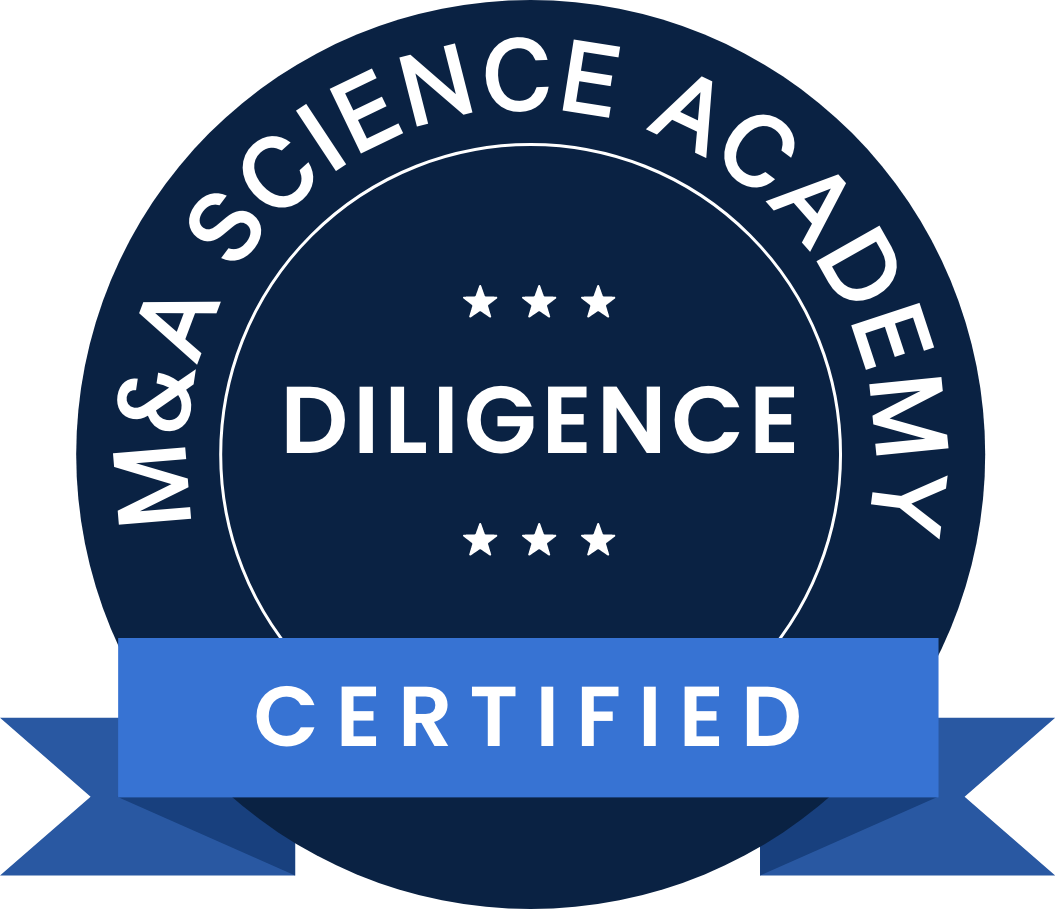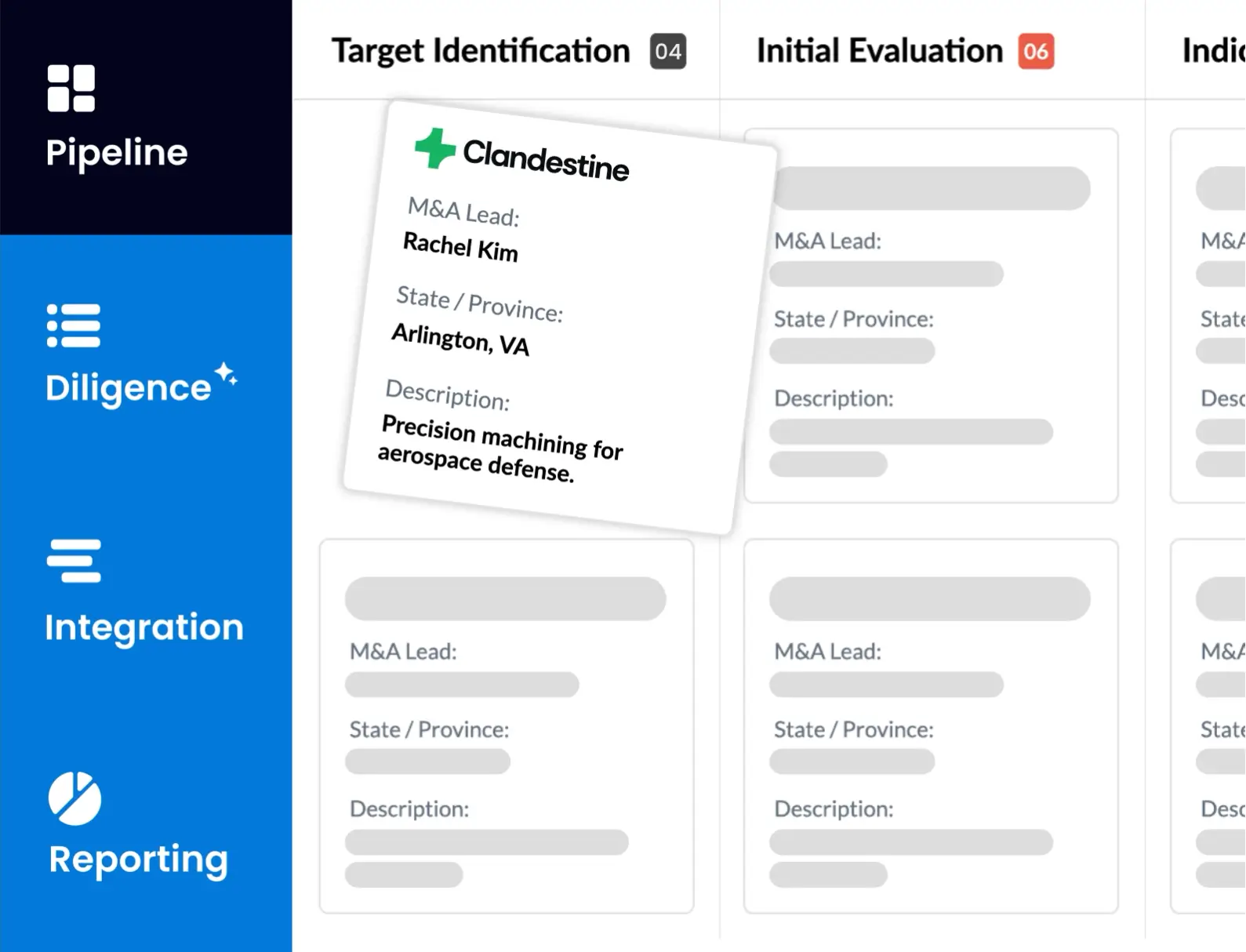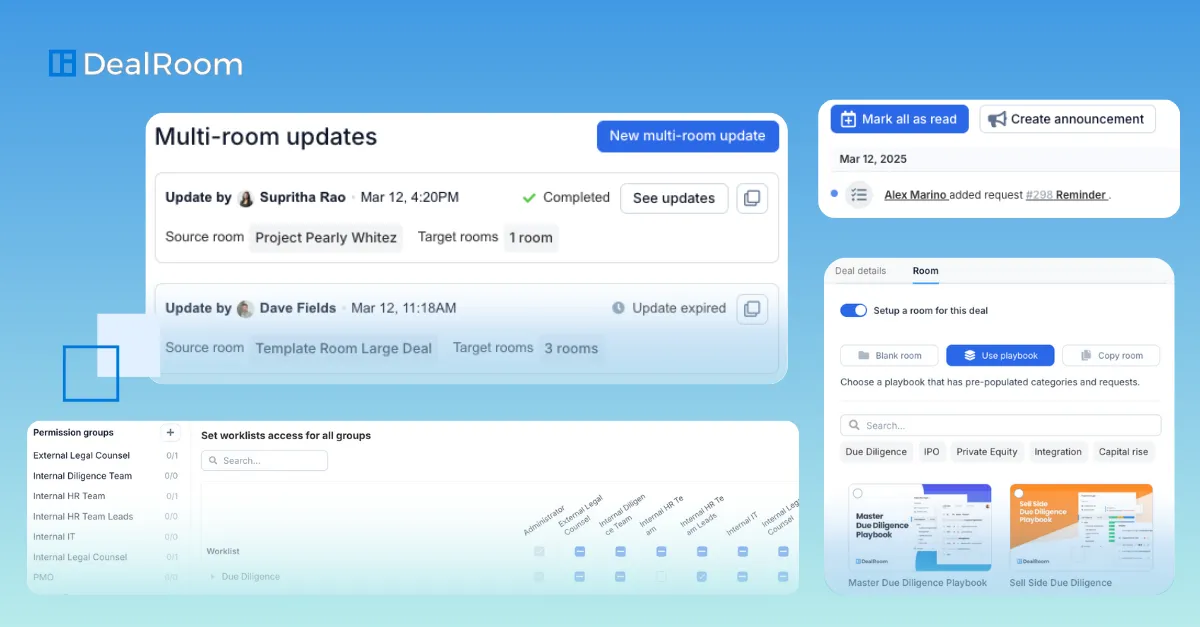Mergers and acquisitions (M&A) are among the most strategic ways for companies to accelerate growth, increase market share, or diversify their operations. Navigating an M&A deal requires a structured approach to ensure success, but traditional approaches are increasingly inadequate for modern businesses. They rely on fragmented systems and a reactive, seller-driven mentality that often results in poor integration and strategic misalignment.
The Buyer-Led M&A™ framework changes this dynamic by putting the buyer in control of the process, ensuring strategic alignment, efficiency, and the creation of long-term value. This approach offers a more cohesive, thoughtful way forward, promoting a seamless process, synchronized planning, centralized data, scalability, and a win-win strategy for both buyers and sellers.
In this article, we’ll discuss the Buyer-Led M&A™ framework and how this approach can benefit your M&A strategy.
Here’s what we’ll cover:
- Challenges of Traditional M&A Approaches
- Why Buyer-Led M&A™?
- Real-World Examples and Implications
- Frequently Asked Questions
- Final Thoughts
Challenges of Traditional M&A Approaches
M&A has long been seen as a strategic tool for inorganic business growth and expansion. However, the traditional approach to M&A is fraught with challenges that can make even the most promising deals turn into costly mistakes.
Traditional M&A processes are disjointed, relying on multiple, incompatible tools that slow down decision-making and create unnecessary risks. Banker-driven approaches tend to focus on deal closure rather than strategic long-term value. The emphasis on fees and closing can overshadow critical elements like integration planning, often resulting in poor post-merger outcomes.
Let’s explore some key pitfalls in traditional M&A approaches and how a more thoughtful, strategic approach can overcome these obstacles.
Deals without Purpose: The Pitfall of Reactive Decision-Making
One of the most significant challenges in traditional M&A is the tendency to make deals impulsively or without a clear, strategic purpose. Often, companies are driven by excitement or competitive pressure, leading them to jump into bidding wars or acquisitions without fully considering how the deal aligns with their long-term goals.
For example, a company might enter a competitive auction, driven more by the rush of the opportunity than by a well-defined strategy. They may close the deal quickly, only to find that the cultural fit is poor, synergies are unattainable, and integration plans were hastily put together, if at all. This approach may look solid at first, but like a building constructed on shaky ground, cracks soon begin to appear.
The solution lies in intentionality. Instead of making reactive decisions, it’s essential to define the deal thesis — how the acquisition will add value — and evaluate cultural fit. By prioritizing thoughtful deal sourcing, companies can ensure that every acquisition is a deliberate step toward long-term success, rather than an impulsive move that leads to future complications.
Disconnected Workflows: The Puzzle Pieces of Traditional M&A
In traditional M&A, workflows are often fragmented, with teams relying on disparate tools and systems. It’s like trying to assemble a puzzle with pieces scattered across different rooms. The result is inefficiency, confusion, and poor coordination, which can delay or even derail the deal.
Consider a situation where a company relies on spreadsheets for tracking, emails for communication, and shared drives for data storage during an acquisition. With information spread across multiple platforms, it’s easy for critical details to be lost, and team alignment suffers. These disjointed processes lead to delays and missed opportunities.
The answer to this problem lies in Unified Processes, Tools, and Data. By bringing everything together in a central platform like DealRoom’s M&A Platform, companies can create a single source of truth where all stakeholders can access real-time information. This improves collaboration, eliminates inefficiencies, and ensures everyone is on the same page throughout the deal-making process.
The Disconnect Between Diligence and Integration
Due diligence and integration are the two critical phases of M&A, and when they aren’t properly aligned, the entire process can fall apart. In traditional M&A approaches, there is often a disconnect between the due diligence process and the integration strategy.
For instance, a company may spend months on due diligence, only to ignore key findings during the integration phase. As a result, critical issues may resurface post-close, leading to delays in Day 1 Readiness and missed synergies.
To avoid this, it’s crucial to synchronize diligence and integration. Findings from due diligence should directly inform the integration strategy, ensuring that both phases are aligned from the start. When these processes work in parallel, it reduces redundancies, improves efficiency, and prepares the company for a smoother transition.
Scaling M&A: Avoiding Chaos During Rapid Growth
As companies scale through acquisitions, the volume of deals can become overwhelming. Traditional M&A approaches often lack the scalable structures needed to manage multiple concurrent acquisitions without sacrificing quality or speed.
Consider a roll-up business scaling rapidly through acquisitions. Without scalable processes in place, teams can become overwhelmed, leading to bottlenecks, faltering integrations, and a decline in team morale. The result is chaos, undermining the potential value of the deal.
Building for scalability is crucial to managing growth effectively. This means adopting repeatable workflows, flexible structures, and continuously refining processes based on lessons learned from each deal. By creating a scalable M&A engine, companies can handle growth without strain and continue to execute successful acquisitions at scale.
M&A as a Partnership: Fostering Win-Win Relationships
M&A should be viewed not just as transactions but as partnerships. Traditional M&A approaches often fail to account for the importance of creating value for all stakeholders — buyers, sellers, employees, and customers. Without addressing cultural differences and fostering collaboration, integration can become a source of friction, leading to high employee turnover and depreciating the value of the deal.
For example, a healthcare company might acquire a smaller firm but fail to address cultural differences between the organizations. Employees at the acquired company may feel alienated, leading to frustration, turnover, and integration challenges. This erodes the value of the acquisition and undermines the overall goal of growth.
The key to overcoming this challenge is the Win-Win Approach. By prioritizing collaboration, cultural alignment, and clear communication, companies can ensure that all stakeholders benefit from the deal. Fostering trust and shared goals ensures a smooth transition and sustainable growth, creating long-term value for both the buyer and the seller.
"Way back in my career, the deal team went and executed the transaction, and then when they knew it was gonna happen, they set up an integration team. You had to do that data flow information sharing, which takes time and it's inaccurate. What's happened over time is integrating the integration team into the deal team at the right level to make sure the handoff is seamless."
Speaker: Keith Crawford, Global Head of Corporate Development, State Street Corporation
Shared at The Buyer-Led M&A™ Summit (watch the entire summit for free here)
Why Buyer-Led M&A™?

The Buyer-Led M&A™ framework is a strategic approach to navigating the complexities of M&A activities, ensuring businesses conduct deals with intentionality, structure, and alignment to long-term goals. Here are the key reasons why businesses should adopt this framework.
Strategic Alignment Over Impulsive Decisions
This framework encourages companies to avoid hasty or reactive M&A decisions. Focusing on thoughtful deal sourcing and ensuring alignment with the business’s long-term strategy enables companies to ensure that each acquisition contributes meaningful value.
It emphasizes continuous alignment on the deal’s thesis, cultural compatibility, and integration strategy, which are critical to making M&A a purposeful, rather than impulsive, process.
Unified Processes, Tools, and Data

Fragmented systems and scattered communication channels can make even a well-planned acquisition feel chaotic. Picture teams navigating endless spreadsheets, buried email threads, and outdated reports—inefficiency at its peak.
Buyer-Led M&A™ focuses on centralizing everything in one place, streamlining the M&A process from start to finish. Here’s how:
- Unified platform for all information. A single hub for diligence reports, integration plans, and real-time updates, ensuring everyone stays aligned.
- Seamless cross-team collaboration. Legal, finance, marketing, and HR work with the most up-to-date data, eliminating version control issues.
- Data-driven decision-making. Advanced tools identify trends and risks early, providing smarter, faster insights.
This ensures smoother information flow and control across the entire M&A lifecycle, providing businesses with greater visibility, accuracy, and efficiency. In particular, it maximizes AI capabilities to boost ROI throughout the process, while promoting better alignment and collaboration among all stakeholders.
Synchronized Diligence and Integration
One of the most critical advantages is the synchronization of the due diligence and integration phases. Traditionally, these stages can operate in silos, leading to delays and inefficiencies.
When following the framework for Buyer-Led M&A™, these phases are aligned early in the process. This ensures day-one readiness, meaning businesses can more quickly realize synergies and avoid redundant or overlapping work post-close. This approach reduces the risk of costly integration issues and accelerates value creation.
Scalability and Efficiency

As businesses grow and acquire more companies, this framework supports scalable operations by creating efficient processes to handle multiple concurrent acquisitions. It encourages continuous learning, where each deal's insights help refine future acquisitions.
Additionally, it promotes flexible team structures, preventing burnout and ensuring optimal resource allocation to manage an ever-increasing deal flow, leading to improved overall deal success.
Win-Win Approach
The Buyer-Led M&A™ framework stresses the importance of creating value not just for the buyer, but for the seller as well. It takes a holistic view of the deal, considering not just financial outcomes, but the integration of people, product, and physical assets.
By ensuring that human capital is optimized in the post-close entity, businesses can foster stronger relationships, smoother transitions, and greater long-term success for both parties involved.
Real-World Examples and Implications

Let’s review a few real-world examples and their implications to illustrate how Buyer-Led M&A™ can streamline transactions and improve outcomes.
Amazon and Kiva Systems
Amazon acquired Kiva Systems in 2012 for $775 million. Kiva specialized in robotic automation technology for warehouses, which was attractive to Amazon for its potential benefits to operations and fulfillment processes. This allowed Amazon to use advanced robotics to improve efficiency, reduce costs, and streamline inventory management, revolutionizing its supply chain.
However, while Amazon integrated Kiva’s automatic guided vehicles (AGVs) technology, the Kiva robots only operated in a designated area completely separate from Amazon employees. In 2022 — a decade after the deal — Amazon released its first fully autonomous mobile robot (AMR).
Amazon’s AMR, named Proteus, was able to work among human employees, unlike Kiva’s AGVs.
One of the critical lessons from Amazon’s acquisition of Kiva Systems is the importance of carefully structuring the implementation timeline for acquired technologies. While the deal was strategically sound and aligned with Amazon’s long-term vision, the delay in fully leveraging Kiva’s robotics highlights key considerations that could have been optimized using Buyer-Led M&A™.
The Never M&A on Impulse principle encourages businesses to continuously validate their deal thesis and execution strategy. With Kiva, Amazon may have underestimated the challenges of fully integrating robotics into human-centric workflows, leading to an extended timeline.
A structured implementation roadmap, developed during the diligence phase, would have allowed Amazon to accelerate technology adoption post-close. By mapping out potential challenges early, the company could have worked to resolve them before the deal closure, reducing the time lag between acquisition and full operational impact.
Amazon’s acquisition of Kiva aimed to enhance its warehouse efficiency through automation, yet the gradual rollout limited how quickly those efficiencies were realized. A better post-close integration strategy would include identifying early use cases to test Kiva robots in live warehouse environments, developing workforce training to ensure seamless human-robot collaboration, and establishing clear integration milestones to fully leverage the technology within a defined timeframe.
Daimler-Benz and Chrysler
German automaker Daimler-Benz merged with American car manufacturer Chrysler in 1998 to form DaimlerChrysler in a $36 billion deal. Daimler-Benz’s merger with Chrysler was driven by a desire to create a global automotive powerhouse, but the deal lacked careful planning and consideration of long-term cultural and operational fit.
The merger suffered from different corporate cultures and operating models, leading to friction in integrating systems and processes. Daimler-Benz’s more conservative German culture clashed with Chrysler’s more freewheeling American ethos.
A more careful, long-term perspective would have been beneficial. Daimler-Benz could have approached the acquisition with a clearer understanding of the specific strategic advantages it was seeking from Chrysler, such as market share in the U.S. or a stronger presence in emerging markets. This would have helped define a more realistic integration strategy.
The merger ultimately failed to create a win-win scenario. The lack of strategic fit and the inability to integrate effectively led to a loss in value for both parties, culminating in the eventual breakup in 2007.
Disney and Pixar
In 2006, The Walt Disney Company acquired Pixar Animation Studios for approximately $7.4 billion. The merger revitalized Disney's animation division, leading to a series of successful films such as "Toy Story 3" and "Up." The merger allowed for the sharing of technology and creative talent, enhancing both companies' capabilities.
Disney executed this deal with clear strategic goals: revitalizing its animation division and creating synergy in production. This shows careful deal sourcing and alignment with long-term goals.
Berkshire Hathaway and GEICO
Warren Buffett's Berkshire Hathaway acquired a controlling stake in the insurance company GEICO in 1996 for $2.3 billion. The acquisition provided Berkshire Hathaway with a steady stream of cash flow from GEICO's insurance premiums, which was then invested in other ventures.
This acquisition was calculated and strategic. Buffett understood the value of GEICO’s business model, including its ability to generate consistent cash flow. Rather than an impulsive acquisition, this deal was based on a well-defined investment thesis, aligning with the never M&A on impulse principle.
Unlike many traditional acquisitions that involve complex integration challenges, Berkshire Hathaway allowed GEICO to retain its operational independence, demonstrating the win-win approach pillar of Buyer-Led M&A™. This ensured that GEICO could continue growing while benefiting from Berkshire’s capital and strategic oversight, creating long-term value for both entities.
By acquiring a company with a strong, scalable business model, Berkshire Hathaway ensured that GEICO’s cash flow could fuel further investments. The built-for-scalability principle was effectively applied here, as Berkshire’s decentralized management approach allowed GEICO to expand without interference, maintaining efficiency and market leadership.
Frequently Asked Questions
What is an M&A framework?
An M&A framework is a structured approach to evaluating and executing mergers and acquisitions. It includes understanding the strategic goals, evaluating the target company, identifying potential benefits and risks, and planning for integration.
How does Buyer-Led M&A™ differ from traditional M&A frameworks?
Unlike traditional M&A, which often follows a seller-driven approach with fragmented workflows, Buyer-Led M&A™ focuses on structured processes, synchronized diligence and integration, and a clear strategic vision.
Can Buyer-Led M&A™ be applied to all industries?
Yes, Buyer-Led M&A™ is industry-agnostic and can be effectively applied to technology, finance, healthcare, logistics, and more.
Final Thoughts
Buyer-Led M&A™ offers a strategic, structured approach to M&A, emphasizing the importance of aligning business goals, optimizing integration, and fostering collaboration. It enables companies to avoid the pitfalls of impulsive decision-making, disconnected workflows, and poorly planned integrations.
By prioritizing strategic alignment and ensuring that both diligence and integration are synchronized, Buyer-Led M&A™ helps create long-term value, making each deal a deliberate, thoughtful process. Additionally, its focus on scalability and a win-win approach ensures that all stakeholders benefit from the acquisition, fostering smoother transitions and sustained growth.
Adopting this buyer-led approach to M&A not only improves the likelihood of deal success but also maximizes the potential for creating lasting value. For companies looking to grow, diversify, or expand through acquisitions, Buyer-Led M&A™ provides the clarity, structure, and alignment needed to turn M&A ambitions into successful, transformative outcomes.



.webp)















.jpg)



.webp)
.webp)
.webp)






.png)
.png)
.png)
.svg)

.svg)
.png)

